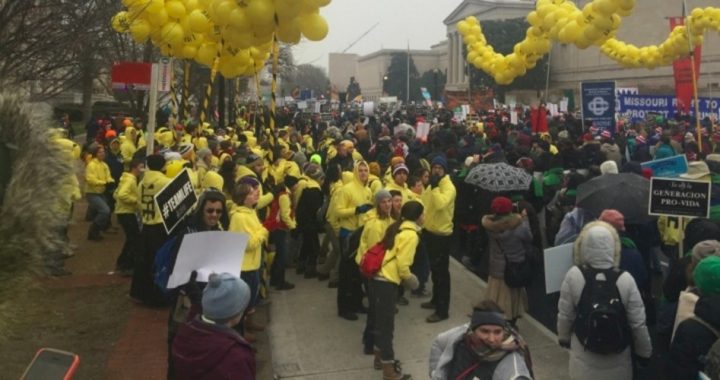
While the nation’s capital was preparing to shut down due to the inclement weather predicted, thousands of pro-life activists and proponents for human life from around the country were gearing up to brave the freezing weather and possible snowstorm. Friday, January 22, marked the 43rd anniversary of Roe v. Wade, and on that day the March for Life celebrated its 42nd march in peaceful protest. Beginning in 1974 as a small demonstration, the organization now heads up the largest pro-life event in the world, with this year’s theme being adoption.
Although city officials reminded the March for Life organizers to prioritize the safety of their participants, a reminder that rang peculiarly of a hint to cancel, the event continued as it has every year, regardless of the weather. Jeanne Mancini, president of the March for Life, noted, “Tens of thousands of people from across the country have traveled to Washington for this massive event and we ask participants to use their best judgment as to whether they should come in person or watch on TV.” She added, “We are very concerned for people’s safety and want everyone to be cautious. However, the pro-life community is also concerned for the safety and well-being of the innocent, unborn in the womb.”
Reading some media reports, one might believe that this year’s march was minimal, at best. However, even with the cancellations of some groups planning to attend, the march was anything but meager, as the organizers of the march believed more than 400,000 to be in attendance. Among these marchers were college students, families, celebrities, and even barefoot monks enduring the bitter weather.
Actor Kelsey Grammer and his wife Katye joined the crowd, sharing a photo of themselves on their Instagram. Last October another picture of Grammer circulated showing him in a pro-life t-shirt reading, “Would it bother you more if they used guns?”
Margie Simonton traveled with her husband and three of her daughters, from Cocoa, Florida, for her first March for Life. Impressed with the number and variety of people, she said that most notable was being in “the crowd of so many people who are all on the same page in regards to this critical issue in our country. So many people despite the freezing temperatures and the heavy snow.”
Having attended the Walk for Life many times on the west coast, Soraya Pierman of Sacramento, California, while spending a semester in D.C. at American University, joined the east coast march for the first time. She felt the chant ringing out in the crowd, “Hey Obama, your mama chose life,” helped put things in perspective. “Everyone is fine with abortion until you put a face to it and then it becomes harder to justify. No one ever knows who the world loses to abortion,” she said.
Sean Fitzgerald, headmaster of Gregory the Great Academy in Scranton, Pennsylvania, recalled a meeting between Mother Teresa, a strong and determined advocate of the unborn, and Hillary Clinton. As he recounted the exchange, Hillary asked, “Why do you think we haven’t had a woman as president yet?” Mother Teresa’s unhesitating response was, “Because she has probably been aborted.”
Signs and balloons held by marchers enduring the cold with smiling faces packed the area as the people mingled with like-minded individuals and listened to the speakers who came to inform and encourage. In response to speaker Rand Paul’s question, “Can a nation long endure that does not respect sanctity of life?” the obvious answer “No!” was sent back from the throng.
Steve Antosh, of Fairfax, Virginia, believes, “There is not just a moral problem, there is a political problem.” If there were no moral problem, mothers would not have their babies legally killed in the womb, regardless of what the law says. If there were no political problem, the government would protect the sanctity of innocent human life — inside as well as outside the womb. Yet the womb, which should provide a safe haven for the unborn child until birth, has instead often become a death chamber because of the intervention of the abortionist. According to the Guttmacher Institute, four in 10 unintended pregnancies in the United States end in abortion, and one third of the women in America will have an abortion by the age of 45.
However, many believe hope is not lost. Eric Cantor, Virginia Republican, addressed the crowd. “You, the marchers, the advocates, who don’t mind enduring the worst weather Washington could throw at you for the opportunity to change one heart and one mind, you are our movement’s not so secret weapon,” he said.
Father Frank Pavone of Priests for Life believes that with the number of pro-life governors and legislators, there will be more progress in the states. “The status of the unborn child is increasing. Medical science acknowledges the [unborn] child as our newest patient. Fetal therapy, fetal diagnosis, and surgery — no question — and laws are beginning on the state level to recognize the unborn as a real person, as a real victim.”
Unfortunately, these real victims have no voice of their own, which is why March for Life exists. Rick Santorum, former Pennsylvania senator, said of the pro-life cause, “This movement is not a bunch of moralizers standing on their mountaintop preaching what is right.” After living their beliefs everyday in many different fashions, volunteering at pregnancy clinics, counseling pregnant women, or simply speaking up in defense of life, pro-lifers come together one day of the year to be the united voice of the unborn. As the March for Life’s Jeanne Mancini said, “The movement to end abortion in this country is bigger than us…. This is a cause that is worth our best efforts and dedication, despite difficult circumstances.”
Photo: Soraya Pierman



